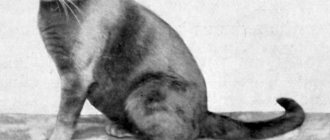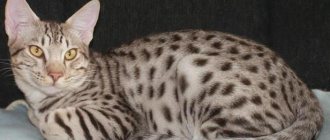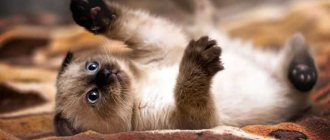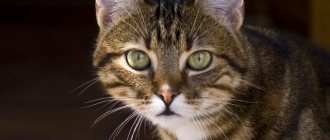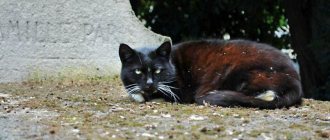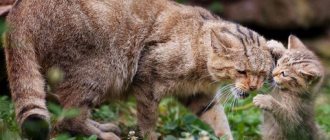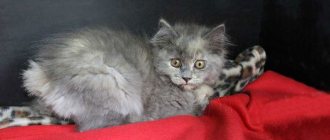Description and features
Serengeti cats visually resemble servals - just as muscular, graceful and wildly beautiful. There is sophistication in every movement, which is due to the long limbs and chiseled neck. The large ears sticking out on the top of the head immediately catch the eye. Because of this, the animal seems to be constantly on guard.
Likes to play
Their fur is soft and silky, mostly spotted in color. The size of cats is also impressive - adult cats gain up to 10 kg (sometimes much more). The breed is special not only in its external description, but also in its behavior and temperament. Cats are distinguished by increased self-confidence and equanimity, and developed intelligence. All this is combined with tenderness and affection towards the owner and members of his family.
But the Serengeti is not suitable for everyone to keep at home. It's all about their excessive "talkativeness", curiosity, hyper-mobility and persistence. They need a lot of attention, otherwise they will beg for it annoyingly.
Serengeti cats are very energetic
, but they do not conflict with other pets. However, they will always strive to take a leadership position. Against this backdrop, clashes often occur, especially with dogs.
Health
Despite their impressive size, representatives of the breed live only 10–12 years. It is unknown what causes such a low life expectancy, especially since their health is truly excellent. The only thing that is observed is a predisposition to urolithiasis (most often found in cats). The disease occurs due to a deficiency of vitamin A in the body, digestive pathology, unbalanced nutrition, hormonal disorders, complications after colds.
Characteristic symptoms:
- the stomach increases in volume;
- the animal becomes restless, constantly meows, tries to attract attention to itself;
- often licks the reproductive organs;
- goes to the toilet in the wrong places, often right in front of the owner;
- there is a frequent urge to urinate, but the pet cannot relieve itself;
- Blood clots appear in the urine.
If such symptoms occur, you should urgently go to a veterinary clinic, since it is impossible to cure the animal on your own. Treatment includes a whole range of procedures, sometimes surgery cannot be avoided. If medical care is not provided in a timely manner, death is possible (especially in pets aged 1–5 years).
History of origin
The closest relative of Serengeti domestic cats is the African predator Serval. It is a mixture of lynx and caracal, but more closely resembles a cheetah. At home, they are tamed and kept in farmsteads, but with safety precautions in place.
Serval
Breeders have not lost hope of creating a small cat, identical to the Serval, but with an easy-going disposition. Attempts have been made to cross wild representatives with domestic ones. As a result, the Savannah breed appeared. There was no continuation, since many problems arise with their breeding. The first males are mostly sterile. Also, in the absence of an infusion of wild serval blood, cats lose their original characteristics over time.
Savannah cat, obtained by crossing a Serval and a domestic cat
American Karen Sauzman took a different path. She made an attempt to crossbred purebred domestic cats, similar in appearance to a serval. Preference was given to Bengals and the Oriental Shorthair breed. From the first it was planned to take large dimensions, rich color, from the second - slender legs, large ears and sophistication in habits. Both of them have pronounced spotting, which was also useful. Then other breeds were involved: Abyssinian, Maine Coon.
On a note! The first Serengeti were born in 1994. The breed was named after a reserve in Tanzania, where servals and many other game live.
The Serengeti breed is still young, experiments on it do not stop. It has not yet received official status, but is recognized by the TICA association. He cannot participate in exhibitions, because a limited number of catteries are engaged in breeding cats (at least 50 are required).
Kinds
Today, there are no more than one thousand unique Serengeti cats on the planet. Only 20 breeders are working to breed domestic servals. Working crossbreeding with related breeds is allowed. In the process of improvement, the following groups are officially recognized as varieties of the Serengeti by color type:
- tabby – brown type, with contrasting spotting, brown pads, brick-colored nose;
- solid - dim spots, the so-called ghostly spotting of the coat, on a brownish background, the pads and nose are black;
- silver – variants of black smoky with random spots, silver with deep black markings.
Serengeti wool does not allow a pronounced ticked color, white flashes, or a rosette pattern.
Breed standard
What the Serengeti should look like according to the standard:
| Head | In the form of an elongated wedge, smoothly expanding from the nose to the ears. The cheekbones and whiskers are not prominent. The chin is well developed. |
| Ears | This is the “calling card” of the Serengeti. They are large - the height corresponds to the length of the muzzle. Set high, with a short distance between them. The shells are wide and recessed at the base, gradually narrowing and forming rounded ends. |
| Nose | Smooth, the same width throughout with a black “patch”. |
| Neck | Elongated, quite thick. Its diameter increases from the skull to the body. |
| Eyes | Small and round, but not convex. They are quite far from each other. Golden-green and dark brown shades of the iris are preferred. |
| Body | Harmoniously built, muscular, strong. Smooth back line. Males are much larger than females. |
| Limbs | Long, slender, strong. Paw pads are oval. |
| Tail | It can be of different lengths, but it is preferable that it reaches the shoulder. It is wider at the base and tapers towards the tip. Must end with a black border. |
| Wool | Short, dense, soft and silky to the touch. The undercoat is completely absent. The guard hairs are clearly visible. |
Prominent ears will come to cats of the Serengeti, a wary look
Serengeti cat color
The standard allows for several coat color options on the Serengeti. The most common:
- spotted tabby;
- black;
- brown;
- silver-gray.
The spots on the body should be round or slightly elongated horizontally, and the tail should be striped. On the woolly side of the ears there should be a specific pattern, like on the pads of human fingers.
Color silver-gray
Colors
This breed can have several types of colors:
- It can be a black spotted tabby (has contrasting black spots).
- Black, smoky or with shades of gray (has ghost mottledness).
Despite the color, the spots are always the same; they should have a round shape, slightly elongated only in a horizontal position. The presence of a dark path that comes from the inner corners of the eyes is very much appreciated.
But with all the advantages, there is, unfortunately, a drawback in their coloring - these are ordinary white, red, and spotted cats. However, in ordinary spotted cats, the spots are elongated in a vertical direction, which is not typical for representatives of the Serengeti.
Personality of Serengeti cats
Unlike their wild “twins” the Servals, the Serengeti are friendly and open to communication. They quickly become attached to their owner and follow him around the house relentlessly. If you deprive your cat of attention, she will persistently beg for it, trying in every possible way to make herself known: rubbing herself, laying on the keyboard, resting on her legs and resorting to other tricks.
The Serengeti does not tolerate being left alone for long periods of time. Rough treatment is alien to them. If they are treated poorly, they will grow into an aggressive and embittered animal.
Serengeti are intellectuals by birth, which, along with their stubbornness, causes a lot of trouble. If they are planning to do something, no prohibitions will stop them - they will find a way to do it their own way. They should not be spoiled too much, because in this regard cats are insatiable and begin to become impudent.
Serengeti are extremely inquisitive and active, easy to train
They are leaders by nature, so they get along with other pets only if they recognize them as a commander. They will desperately defend their championship until they achieve what they want. They are fearless and will not shy away even from a large dog. They are ready to be the first to fight when their owner is in danger.
They cannot remain calm for a long time; they constantly find active activities. Their playfulness and perkiness benefit children. You will never get bored with such a pet. Any object turns into a toy for them.
Favourite cat
The house must have special structures for cats to climb and jump on.
Owner reviews
Since the Serengeti is a relatively new breed, it has not yet gained widespread popularity among ordinary people. But those lucky few who have such cats at home speak of them with great warmth. According to them, this is an ideal option for those who have never had pets. Representatives of this breed are good because they do not require special care, are unpretentious in food and easily get used to a new environment. Some owners even travel with their Serengetis.
These beautiful and incredibly curious cats try to poke their noses everywhere, which is why many professional breeders compare them to researchers. They also say that representatives of this breed are very affectionate and sociable. They try by any means to gain the attention of their owners. Cats can get in the way, poke their noses, caress and paw until the owner understands what they want from him.
In addition, experienced breeders noticed one interesting feature. These playful and very active animals can push fragile objects with their paws. Therefore, those who have a Serengeti kitten in their home need to remove all small and easily breakable objects from the accessibility zone in advance. Otherwise, an animal carried away by the game may accidentally throw them onto the floor and be injured by fragments.
Defects in appearance
Work on this breed is still ongoing, and therefore the standards have not yet been officially recognized by international associations of animal lovers. But the defects of the breed include the following:
- two-color spots of unclear outlines;
- spotted inclusions transforming into stripes on the sides;
- squatness;
- light weight;
- limbs not long enough.
It is acceptable to have a light inclusion in the chest and groin area. But snow-white “pants”, the absence of a black tip on the tail and whitish spots on the body are grounds for disqualification. Blue eyes are also not welcome.
Tendency to diseases
Like other mustachioed pets of the Serengeti, they can get sick from time to time. This is influenced by a number of factors: nutrition, care, living conditions, timeliness of vaccination. But in general, the breed has good immunity.
The Serengeti are predisposed to hereditary disorders of the genitourinary system. The symptoms are:
- difficulty urinating;
- bloody discharge in the urine;
- relieve yourself past the tray.
In this situation, you need to contact a veterinarian; self-medication is unacceptable.
Signs of a cat's disease
Care and maintenance
Due to the activity of the Serengeti, they would be better off in a spacious cottage with a large outdoor area. There they will be able to run freely and also hunt small animals (birds, rodents). But they also take root well in apartments. By letting them go outside alone, you don’t have to worry, they won’t run away forever.
Serengeti like to move along branches and hunt birds
If you accustom a kitten to a leash from childhood, then in the future the cat will not resist it on walks with its owner.
Serengeti are not picky about their care. Standard procedures:
- Regular examination of the eyes and ears to detect discharge. Remove them with a swab soaked in warm water.
- Combing the coat once every 2 weeks. Due to its thickness and shortness, tangles do not form. But such a procedure will serve as a massage for the skin. To do this, use a rubber brush.
- Swimming, if necessary. Cats are capable of keeping themselves clean, so bathing procedures are only needed when they are very dirty.
- Teeth brushing is required if your pet is fed soft food. This often provokes the formation of tartar. To do this, buy special toys and treats at the pet store.
To prevent your pet from scratching the furniture, it is advisable to install a scratching post. Then the cat will grind its claws down on its own. A special tool is used to cut them.
Trim the claws carefully so as not to injure the animal.
On the bed
Nutrition
Serengeti can be fed both natural food and industrial cat food (dry, canned). The main thing is to choose one thing. In the second case, preference is given to premium food that contains all the useful substances for the full development of the animal.
Full bowl
Professional feed formulations guarantee your pet complete and balanced nutrition
If natural products are a priority, then the menu is compiled with the participation of a veterinarian nutritionist. Food must be of high quality, fresh and prepared separately. Most of the diet should include meat (veal, beef, chicken, turkey). In addition, the following products are recommended:
- fresh vegetables;
- chicken eggs;
- cereal porridge;
- fermented milk products.
Additionally include vitamin and mineral substances , sold separately.
Salt, sweets, and spices are completely excluded from the list. Fried foods and smoked foods, baked goods, and bony fish are also unacceptable.
The Serengeti is not prone to overeating. So you can leave food in the bowl, your pet won’t eat too much.
In fact, it is enough to feed adult representatives twice. Babies up to six months and pregnant women are fed up to 4-5 times.
With a kitten
Breeding
Cats reach sexual maturity by one year. Even if the female comes into heat earlier, it is better to wait until the hormonal levels stabilize. Breeders advise resorting to mating no more than 2 times every 3 years . After giving birth, the animal needs about 10-11 months to fully recover. With frequent births, the cat’s body is depleted, which can lead to a shortened lifespan.
It is better to choose a partner in professional nurseries (in America or Great Britain). It's good if the cat is already untied.
Before such a significant event, both animals are shown to the veterinarian to rule out any diseases. It is preferable to perform mating on the territory of the “groom”. The cat is brought to him and left for several days (maximum 6-7).
Looks like I noticed something
Nutrition
The simplest feeding option is to put the animal on specialized food. It will not only nourish your pet, but also give it all the necessary vitamins, minerals, micro- and macroelements.
With the right food, the Serengeti is very active, their coat is shiny and they are not afraid of any diseases.
You can feed representatives of this breed with natural food, but this is a more troublesome task, since you need to add the necessary substances yourself. If you feed your animal regular food, remember that it should not contain any salt or spices.
Half of the serving should be proteins obtained from meat or fish, and the rest should be vegetables and porridge, the latter only 20%. Do not deprive the animal of offal: chicken hearts, navels and liver. Feed small portions of raw, lean chicken or beef occasionally.
Not often, about once a week, add fish to the porridge instead of chicken. Only it should be cooked in a separate container and without bones.
Many Serengeti people love dairy products. Do not deprive your pet of a couple of teaspoons of sour cream and cottage cheese, but you should not give kefir and other fermented milk products. Serengeti cats also love boiled eggs, especially the yolk. Pamper them, but not more than twice a month.
Price
Since the Serengeti breed is rare and is not bred in Russia, the price for kittens is high. You can buy a baby at a nursery for 1000-2000 dollars.
On a note! Trying to save money, many people purchase Serengeti from random advertisements. As a result, they get not a purebred representative, but a crossbreed. That is why it is so important to have the appropriate documents.
Everyone is blue-eyed
Where to buy a kitten?
This is actually a difficult question. After all, there are no nurseries in Russia yet, but there are only one or two of them in the world. At the same time, the Serengeti is already known in our country. The thing is that large Russian nurseries can purchase a Serengeti kitten on order especially for you from their colleagues abroad, but the price will be rather high.
If this doesn’t scare you and you decide to get a pet of one of the rarest breeds, but still decide to monitor prices, be careful, you may encounter scammers. It is better to buy such a rare cat through trusted people. See also rare cat breeds with photos and names.
The Serengeti is a unique cat breed that combines the wildness of the American savannah, extraordinary flexibility and grace, as well as tenderness and devotion to its owner. See also all photos of the Savannah cat breed.
Popular kennels for this breed:
- Russia - (your nursery is here);
- Belarus - (take place);
- Ukraine - (submit an application).
Choosing a kitten
Due to the lack of a fixed standard for the Serengeti breed, problems often arise with choosing a kitten. Many people rely only on photos. To avoid mistakes, it is recommended to seek help from a professional.
Handsome cat
Typically, they are guided by the following signs in an animal:
- good health;
- clean eyes and nose;
- without pathologies of the limbs, spinal column and tail;
- fatness, activity, sociability.
The baby you are purchasing must have routine vaccinations. Kittens bought from foreign nurseries have chips (this is written down in the passport).
Interesting Facts
There are a lot of interesting things to tell about the Serengeti. Here are some fun facts:
- These cats are far from silent creatures; they constantly make different sounds (growling, yapping, purring, hissing, clicking). That's why they are often called "talkers." This is how they talk to others. Sometimes it gets very tiring.
- The Serengeti are selflessly devoted to one person - the owner. This quality is akin to a dog's fidelity. In case of imminent danger, they are ready to immediately rush to defense. Just before this they let out a loud war cry.
- These cats are very jumping, able to overcome heights of 2 meters or more. So it is better to keep the cabinets closed, otherwise they will definitely get in there and make a mess.
Excessive talkativeness is a characteristic feature
Pros and cons of the Serengeti breed
The positive and negative aspects of the Serengeti breed are presented in the table:
| + | — |
| · attractive appearance; · unpretentiousness in care and living conditions; · excellent health; · friendly disposition; · equanimity and confidence are the main character traits; · strongly attached to home. | · too large to be kept in small apartments; · the breed does not have a registered status; · overly active, inquisitive, sometimes annoying; · bore you with “talkativeness”; · are expensive; · rare; · cannot participate in exhibitions. |
Tabby color

